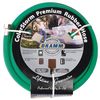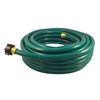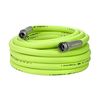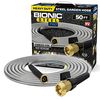You can spend $15 on a garden hose or ten times that amount. Given the basic task of a hose — transporting water from a spigot to a spray nozzle so that you can water the lawn, wash the car or douse the kids on a hot, summer afternoon — it’s tempting to go with the least expensive option. But after testing a slew of garden hoses, the experts at the Good Housekeeping Institute found serious variations in performance, ease of use and durability. While our top overall pick was the most expensive, other moderately priced picks performed nearly as well, and might even be the better choice depending on your situation.
To arrive at this roundup of winners, our experts spent more than 20 hours reviewing technical data, assembling the hoses and putting them through their paces at our backyard testing locations. We also checked in with landscape professionals who handle hoses all the time. “Each garden has different needs, so you need to choose your hose accordingly,” says Jim Russell, a horticultural instructor and garden creator who works throughout the northeast.
Our hands-on testing focused on usability, including how easily hoses connected to the spigot and nozzle. Testers also assessed maneuverability, noting any tendencies toward kinking or cracking, as well as the ease with which the hoses reeled in for storage. Durability was a third criterion, driven largely by material and construction. In the end, we settled on six top-rated garden hoses. They’re not all suited to every application, but somewhere in the mix is the perfect garden hose for you.
Our top picks
Best Overall Garden Hose
Dramm
Rubber Garden Hose
Best Value Garden Hose
Flexon Hose
Light-Duty Garden Hose
Best Expandable Garden Hose
Knoikos
Expandable Garden Hose
Best Garden Hose on Amazon
Flexzilla
Garden Hose
Best Heavy-Duty Garden Hose
BIONIC STEEL
PRO Garden Hose
Best Garden Hose for Small Spaces
HoseCoil
HS1500HP Garden Hose
How we choose the best garden hoses
Our experts start by surveying the current marketplace to identify the garden hoses you’re most likely to find on store shelves and online. We’ve been testing lawn and garden products for decades, so we looked for brands with a track record for reliability.
Hands-on testing took place at the homes of various staff testers, which allowed us to evaluate the hoses in real-world conditions. When it came to reviewing specific models, our engineers and product testers spent more than 12 hours reviewing hundreds of technical and performance data points, including hose dimensions, materials (including lead-free claims), temperature resistance and more.
We then put the hoses through a battery of tests over another 12-hour period. To measure ease of use, we connected each hose to the main spigot and spray nozzle multiple times, noting any difficulties connecting or signs of degradation. We also measured maneuverability, namely how easy each hose was to unfurl and reel in, and whether kinking occurred. Performance was primarily determined by flow rate and the force of the spray, using the same nozzle for each spray. To determine durability, we repeatedly dragged each hose across rough surfaces, including the edge of a brick column and metal steps; applying the same pressure and angle, we checked for early signs of wear and tear to the outer covers. We walked repeatedly on the hoses and connections and rode over them with a bike tire and the wheel of a wooden chaise lounge to ensure they didn’t crack or split.
Our durability tests include pulling hoses at the same angle and pressure across the sharp corner of a brick pier.
Testers also looked for signs of kinking, since this impedes water flow and can also lead to premature cracking.
What to look for when choosing the best garden hose
To find the best garden hose for your needs, think about the size of the property and how much use and abuse the hose is likely to receive.
✔️Length: Garden hoses range from 5 feet long to over 100 feet long. The size of your property is, of course, the deciding factor. Measure from your outdoor spigot to the farthest point in the yard that will require watering; remember that you’ll pick up at least 10 feet from the spray of the hose. The biggest regret we hear from consumers is when they purchase too much hose. “Heavy-duty or extra-long hoses could be more of a pain than a pleasure,” says professional gardener Jim Russell. “Lift up the hose and ask yourself if you’d want to lug it around.”
✔️Diameter: The diameter of the hose affects how much water can move through it. Garden hoses range from 3/8″ to 6/8″ inches. Wider hoses can move several times as much water in the same amount of time, which is especially helpful for cleaning. It will also deliver extra distance on the spray, so you might be able to get away with a shorter hose.
✔️ Material: This factor impacts the hose’s cost, usability and lifespan. Here are the most common options:
- Vinyl: The least expensive garden hoses are made of vinyl. Though you save upfront, vinyl hoses are prone to kinking and cracking, plus they usually have cheap plastic connections that can lead to premature leaks.
- Latex: Another kind of plastic, latex is a common material in expandable hoses. It’s flexible and resilient, which allows it to expand and contract. But it’s not as durable as other materials.
- Rubber: This classic hose material is more durable than plastic, especially if it’s a high-quality rubber such as EPDM rubber — short for Ethylene Propylene Diene Monomer — a weather-resistant material common in the automotive industry.
- Stainless steel: This material has many outdoor applications, from grills to furniture. Stainless steel hoses have the same benefits, namely being rust-proof and weather-resistant.
What’s the best way to store a garden hose?
Let’s first talk about the wrong way to store a hose — in a tangled mess underneath your spigot. This puts extra wear and tear on the hose and turns it into a tripping hazard. Plus, it’s an eyesore. “No one wants to look at a hose, so the more easily it disappears, the better,” says professional gardener Jim Russell. He’s partial to retractable hose caddies, like this version from Frontgate. “The hose is kept out of sight and putting it away is a delight,” he says.
A hose hanger, whether wall-mounted or freestanding, is a more affordable solution for keeping your hose well-organized and out of the way, though it will still be visible. Some hangers feature a winding crank mechanism that helps reel and unreel, helpful if you’re working with a long hose of 75-feet or longer. Otherwise, a manual hanger will do the job for as little as $10.
Why trust Good Housekeeping?
The Good Housekeeping Institute Home Improvement Lab provides expert reviews and advice on all things home-related, including lawn and garden gear. In his role as Director of the Home Improvement & Outdoor Lab, Dan DiClerico brings more than 20 years of experience to the Institute, having reviewed thousands of products for Good Housekeeping, as well as brands like This Old House and Consumer Reports. He has also wielded all kinds of garden hoses over the years tending to the terrace and back garden of his home in Brooklyn.
For this report, Dan worked closely with Rachel Rothman, Chief Technologist & Director of Engineering at the Institute. For more than 15 years, Rachel has put her training in mechanical engineering and applied mathematics to work by researching, testing and writing about products across the home improvement space.
Dan DiClerico Home Improvement & Outdoor Director Having written thousands of product reviews and how-to articles on all aspects of home ownership, from routine maintenance to major renovations, Dan (he/him) brings more than 20 years of industry experience to his role as the director of the Home Improvement & Outdoor Lab at the Good Housekeeping Institute.







